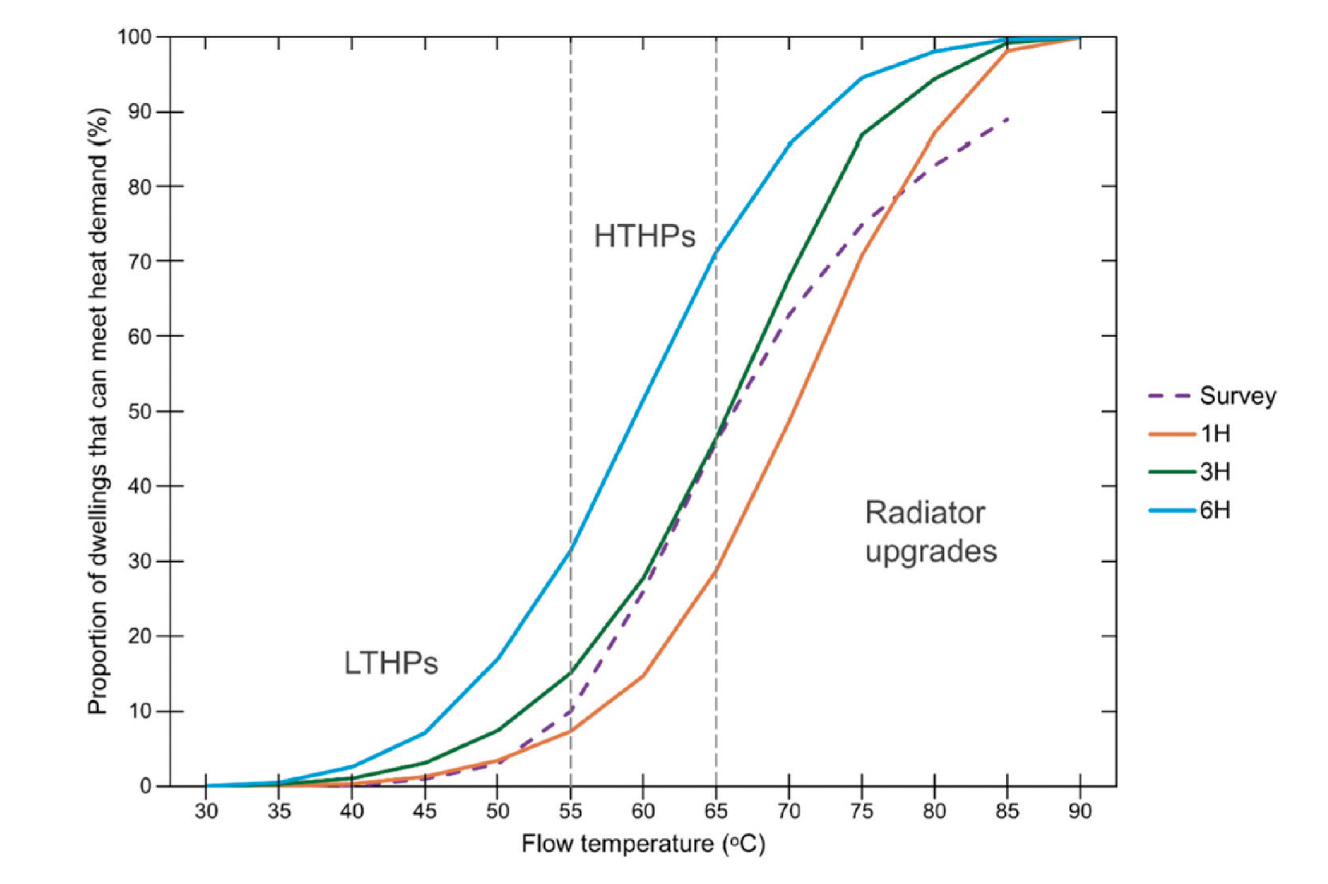
Many more homes in the UK may be heat pump ready than previously thought, according to a recently published paper, ‘Predicting the heat pump readiness of existing heating systems in the UK using diagnostic boiler data’.
The study evaluates the ‘heat pump readiness’ of existing UK housing, with a conclusion that flies in the face of many an established assumption that widespread radiator upgrades and building fabric improvements are essential for heat pump adoption.
Upgrading radiators is common when replacing a boiler with a heat pump in the UK, and is often more cost-effective, but can still be expensive. The paper notes that replacing an entire home’s radiator network can cost £6,000–£7,500. Add in the heat pump and this exceeds the £7,500 grant from the UK’s Boiler Upgrade Scheme. It also adds installation time and disruption to the process. Analysis from this research suggests that the transition to heat pumps may be less disruptive and costly than previously thought.
The research and paper were developed and written by Laurence Childs (UCL), George Bennett, (Department for Energy Security and Net Zero – DESNZ), Stephen Watson (Loughborough University) and Grant Wilson (University of Birmingham). They present a novel approach to evaluating the heat pump readiness of existing UK homes by using diagnostic data from approximately 4,600 domestic heating systems. The aim of the work was to determine the proportion of homes that could switch to heat pumps without needing costly upgrades to their radiators or building fabric. This is a crucial question, because the UK plans to replace gas boilers with heat pumps to achieve net zero carbon emissions by 2050.
Previous survey-based assessments have indicated that 90% or more of UK dwellings would require new radiators to deliver sufficient heat at the lower flow temperatures delivered by heat pumps, particularly low temperature heat pumps (LTHPs) that typically operate effectively with flow temperatures below 55°C.
The study highlights the limitations of survey-based methods for assessing heat pump readiness, because surveys often overestimate heat loss and underestimate radiator output. Measured data captures the real-world performance of heating systems and the heat demand set by occupants.
The study emphasises the need to employ lower flow temperatures when using heat pumps. Gas boilers typically operate at 60-70°C, while heat pumps are more efficient at flow temperatures below 45°C. The analysis revealed that many homes already operate at flow temperatures compatible with heat pumps.
The study used diagnostic data from internet-connected combi boilers, which included gas power input, flow temperature of water going to the radiators, and control information on whether the boiler was providing space heating or domestic hot water (DHW).
The data was used to analyse the relationship between heat demand, flow temperature, and the potential for using heat pumps without upgrades. The study developed a method to estimate the underlying heat demand of a dwelling by using the power profiles of boiler operation, accounting for the heating system’s thermal mass and the rate of heat transfer to the dwelling.
The annual heat demand of boilers in this study closely aligns with the distribution modelled by the National Housing Model, as shown in Figure 1. This suggested that the sample was representative of UK boiler-heated homes.

Figure 1: Comparison of annual gas power input of boilers in this study and annual space heating demand for gas-heated dwellings as represented in the National Heating Model
A theoretical relationship between radiator power output and flow temperature was used to determine the required flow temperature to meet the estimated heat demand. The results were categorised based on maximum flow temperature and peak heat demand, to assess if homes could operate without upgrades when employing LTHPs or high-temperature heat pumps (HTHPs, which typically can operate efficiently with flow temperatures of 65°C). Different time averaging intervals (six, three and one hour) were used to determine the impact of heat scheduling on flow temperature requirements. A longer averaging interval better represents the continuous heating profiles typically used by heat pumps.
The findings suggest that the costs and disruption of heat pump installation could be substantially lower than previously predicted. The use of real heating system performance data can supplement survey-based assessments to identify more accurately where upgrades are needed, thereby facilitating a more rapid heat pump deployment at a national scale.
The study underscores the potential of data-driven testing procedures for designing future heating systems that could lead to more accurate specification of heating systems and enable increasingly cost-effective designs of low carbon heating.
The results also suggest the potential benefits of hybrid heating systems, where supplementary electric heaters or boilers are used to meet peak heat demand, reducing the need for extensive upgrades. The study demonstrated that spreading out the heat load through longer heating periods can reduce the required flow temperatures.
The study analysed a single year of data from boilers in England and lacked detailed information about the associated buildings or heating systems, relying solely on what could be inferred from the boiler type. The absence of return temperature data for most boilers necessitated estimating heating system temperatures. The study highlights that milder winters driven by climate change could further reduce flow temperature requirements.
While the estimated thermal mass of heating systems fell within a plausible range, it was probably overestimated; however, sensitivity analysis confirmed that this had minimal impact on the findings.
Radiator cooling rates were modelled using a simplified interpolation method, which may not fully capture the exponential nature of radiator cooling. A straightforward filter was applied to exclude DHW events, assuming minimal space heating demand during these occurrences.
The study acknowledges that the operational conditions during the data collection period may not reflect typical averages. Gathered after the energy crisis, the data might also reflect occupants underheating their homes. Furthermore, its focus on whole-system data limits the ability to distinguish whether a few critically undersized radiators require replacement or if an entire system upgrade is needed – scenarios that have significantly different cost implications.

Figure 2: A set of cumulative distributions showing the predicted proportion of UK dwellings that could meet heat demand at low temperatures for the three different averaging models, and that applied by the original BEIS survey model
Additionally, the study does not consider other factors affecting heat pump readiness, such as space constraints, noise concerns, or electricity grid limitations.
The paper suggests that there will be varying requirements for fabric and radiator upgrades across dwellings when installing heat pumps, but the extent of upgrades appears lower than previous survey-based estimates.
As illustrated in Figure 1, averaging heat demand over six hours, the model found 31% of dwellings could operate at 55°C or lower without radiator upgrades, compared with 10% in Department for Business, Energy and Industrial Strategy (BEIS)1 surveys. Similarly, 66% of dwellings could operate at 65°C or lower without upgrades, compared with 46% in BEIS surveys. This indicates that up to two-thirds of UK homes may be suitable for HTHPs, with around one-third also ready for LTHPs, provided heating controls allow heat load spreading.
This is a considerably higher figure than previous survey-based analyses, which suggested almost all homes would need radiator upgrades when switching from gas boilers, and indicates a larger potential for heat pump adoption in the UK using existing infrastructure.
The full paper, with references, is available for free from BSER&T at journals.sagepub.com/home/BSE
Notes
BEIS existed until 2023, when it was split to form the Department for Business and Trade and DESNZ.



